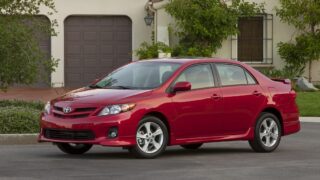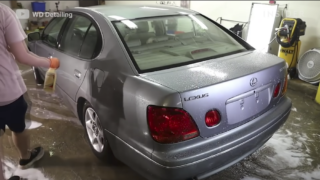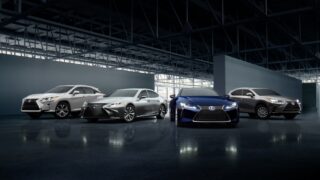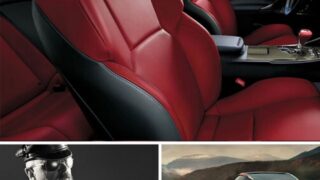2010 Lexus HS 250h Review: Walkaround and Interior Features
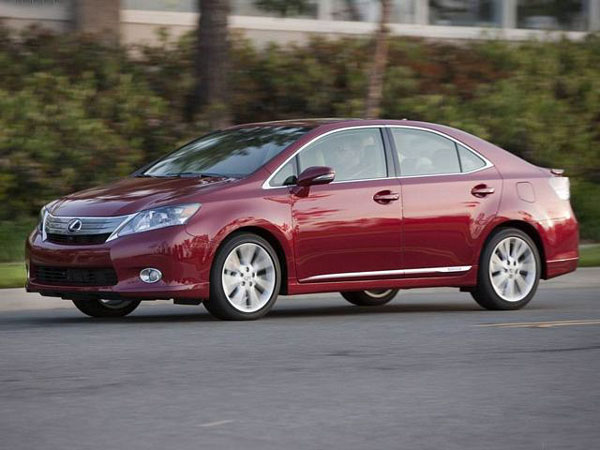
Almost every aspect of the 2010 HS 250h design is modern, technical, and aerodynamically relevant. The new grille contributes to a low coefficient of drag (0.27) by
guiding airflow over the hood, and is set lower than the headlamps, a
Lexus identity trait. The center of the hood is visually well defined,
blending into concave segments that create a sculpted, edgy look.
Sharply angular compound headlamps are mounted high, above the grille,
a design cue in keeping with the top-of-the-line LS600h.
Walkaround
A subtle gull wing shaped roof design helps control airflow to reduce
drag and strengthen the roof structure. The bottom edge of the front
bumper, which flows outward and around the fog lamps, also includes an
air intake for cooling. Front and rear spoilers add to aerodynamic
performance, as do air flow management touches that include spats,
liners in the fenders and air diffuser fins.
Weight reduction was accomplished by use of high-tensile strength steel
and an aluminum hood. Infared-reducing windshield glass reflects heat,
helping to reduce the air conditioning workload for better mileage.
A halogen projector beam headlight system is standard; LED headlamps
and adaptive front lighting are available. The headlamp and tail lamps
have tinted blue inner trim to signal that the HS250h is a hybrid.
There is also a Hybrid badge, plus subtle blue highlights added to the
Lexus logo and engine cover.
Interior Features
The Lexus HS creates a sense of luxury by surrounding the
occupants with technologies that empower and inform, and by use of
premium components and materials throughout.
Inside, there is a high level of standard equipment. The three-spoke
steering wheel and shift knob have leather trim. A 10-way power
driver’s seat with power lumbar support is standard, as dual-zone
climate control, a dust and particle filter, two 12-volt outlets,
Homelink programmable garage door opener, tilt steering column, power
windows and all the cupholders, assist grips and interior detailing we
would expect of a car in this price range.
Interior lighting is crafted to suit the environment. The lighting
scheme includes courtesy lights mounted on the doors, an incandescent
dome light, map lights, LED foot lights, and lights for the glove box
and trunk.
The trunk is large for a car of this size, and has an unusually wide opening, easily accommodating four golf bags.
The HS 250h cockpit is shaped by study of eye movement, sight lines and
economy of motion. Everything the driver needs to look at is mounted
high on the dash, so it can be addressed at a glance. Those controls
that must be touched are mounted down low, within easy reach. The
navigation screen is mounted high but controlled by the mouse-like
Remote Touch device located in the center console, where a driver would
most likely rest his hand. Because of the Remote Touch mouse, the
driver never needs to lean forward to touch the navigation screen, or
keep his finger on an icon while the display scrolls. It’s all
controlled through the mouse, without looking down. It’s a safer
system, one that leaves no fingerprints on the Navi screen.
The transmission shifter, something more like a joystick, is located in
the center of the instrument panel, where it can be bipped into a given
gear by a flick of two fingers.
No small amount of bioplastic material, synthetic fabric made from
vegetable oil, has been engineered into the HS 250h. It’s used in the
trunk carpeting and parts of the interior upholstery, covering about 30
percent of the area. Unlike many plastics used in the automotive
industry, bioplastic is carbon-neutral and does not create a disposal
problem when the life of the car is over. It’s a trend we’re seeing
throughout the auto industry, as the newest cars use ever-higher
percentages of recyclable materials.
The HS builds on the notion that a car should interface seamlessly with
other computers and information flowing from outside sources. The
Bluetooth system is adapted to wirelessly download contact information
from compatible phones, which probably already synchs with most home
and office computers. As a result, all three phonebook databases can be
identical. XM satellite radio, now capable of delivering news on
sports, weather, traffic and stocks in real time, can pull in
information anywhere the car goes. It’s also possible to program in
personally selected information preferences, so a driver can track his
own stock portfolio or follow specific teams.
Another service, Safety Connect, can be used to determine the current
location of a stolen vehicle, call for emergency assist and supply GPS
data to enhance roadside service needs.
Lexus Enform offers a live operator to help drivers find a specific
address, a business, or restaurant, and then sends the coordinates to
the navigation system for routing. Another premium feature, called
eDestination, allows drivers to go online to save and sort destinations
in up to 20 folders, and send as many as 200 destinations at a time to
the vehicle, where they can be downloaded into the navigation system.
By John Stewart

